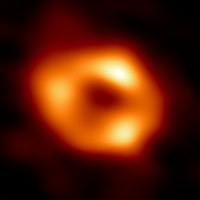
Photo from wikipedia
We show that a 10 year Gaia mission could astrometrically detect the orbital motion of ~1 sub-parsec separation supermassive black hole binary in the heart of nearby, bright active galactic… Click to show full abstract
We show that a 10 year Gaia mission could astrometrically detect the orbital motion of ~1 sub-parsec separation supermassive black hole binary in the heart of nearby, bright active galactic nuclei (AGN). Candidate AGN lie out to a redshift of z=0.02 and in the V-band magnitude range $10 \lesssim m_V \lesssim 13$. The distribution of detectable binary masses peaks at a few times $10^7$ solar masses and is truncated above a few times $10^8$ solar masses.
Journal Title: Physical Review D
Year Published: 2019
Link to full text (if available)
Share on Social Media: Sign Up to like & get
recommendations!